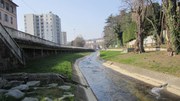
Photos taken in Milan (Italy), Uherský Brod (Czech Republic), Nicosia (Cyprus), have won the top three prizes in the European Environment Agency (EEA) photo competition which this year encouraged photographers to share moments captured in urban areas where they live, work, rest and play.

Rivers and lakes located in European cities and towns are getting cleaner thanks to improvements in waste water treatment and restoration projects which have brought many waterways back to life. New forms of water management contribute to make our cities greener, smarter and more sustainable, but key challenges remain, according to a new report by the European Environment Agency (EEA) released today.

Securing our need for food has become a major threat to the environment, driving increased emissions and over-exploitation of natural resources such as water, soil and fish. Our health and well-being have also been affected. Ensuring nutritious food for all in a fair and environmentally sound way has become a societal, economic and policy challenge across the world. A shared understanding of the food system and the roles different actors — policy makers, producers and other stakeholders in the food supply-chain — play will be crucial to a sustainable future, according to a new European Environment Agency report published today.

The surplus of CO2 emission allowances in the European Union’s Emissions Trading System (ETS) started declining in 2015. This is the first significant decrease since unused allowances started accumulating in 2008. However, the surplus remains substantial, according to the European Environment Agency’s annual report on the EU’s emissions cap and trade system published today.

Significant changes will be needed in the Member States’ energy-generating mix if the European Union is to meet its 2050 goal to cut greenhouse gas emissions by 80-95 % compared to 1990 levels, according to a new European Environment Agency (EEA) report published today. While the European Union has made considerable progress in improving energy efficiency and using renewable energy sources, a well-planned transition out of carbon-intensive power generation is needed to meet the long-term aim of creating a low-carbon society.

A large scale roll-out of electric cars on European roads would result in significantly lower greenhouse gas emissions and lower levels of certain air pollutants, according to a European Environment Agency (EEA) assessment released today. However, widespread use of such vehicles would pose challenges for Europe’s power grid in meeting increased electricity demand.

Chemicals which harm the ozone layer continue to be phased out in the European Union. In 2015, consumption of these chemicals reached its lowest level since 2006, partly due to a drop in imports according to a new report from the European Environment Agency (EEA).

Environmental taxes can contribute to a healthier planet and healthier people. They also spur jobs and growth, are easy to administer and difficult to evade. However, meeting EU climate and other environmental policy targets will erode the existing base for these sort of taxes. This and other systemic factors have implications for the design of future tax systems in Europe, according to an EEA report published today.

Ammonia emissions in Europe have fallen since 1990, but by not as much as emissions of other air pollutants tracked under an internationally agreed United Nations convention. According to a new report from the European Environment Agency (EEA), ammonia emissions increased in 2014, meaning several EU Member States as well as the EU now exceed their respective ammonia emission limits under the convention.

Cities across Europe must step up their adaptation efforts if they are to handle the increasingly complex challenges caused by climate change such as more extreme flooding or prolonged heatwaves. A European Environment Agency (EEA) report published today stresses the benefits of investing in long-term preventive measures that cities should take to improve their resilience.